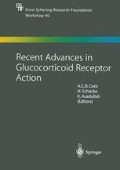Abstract
Glucocorticoids (GCs) have been widely used in the treatment of acute and chronic inflammatory diseases for more than 50 years. They are very effective and represent standard therapies for many inflammatory conditions with immunologic or non-immunologic backgrounds. Unfortunately, the desired anti-inflammatory and immunosuppressant effects are often accompanied by severe and/or partially non-reversible side effects (Table 1). Beside unknown individual factors, dosage and duration of therapy are major contributors to the frequency and severity of these side effects. Thus, long-term and high-dose GC therapy is problematic and partially dangerous. However, no good alternative exists so far, as other anti-inflammatory therapies usually are either less effective (at least in certain indications) or display a high side-effect potential as well.
Access this chapter
Tax calculation will be finalised at checkout
Purchases are for personal use only
Preview
Unable to display preview. Download preview PDF.
References
Beer H-D, Fässler R, Werner S (2000) Glucocorticoid-regulated gene expression during cutaneous wound repair. Vitam Horm 59: 217–239
Belvisi MG, Wicks SL, Battram CH, Bottoms SEW, Redford JE, Woodman P, Brown TJ, Webber SE, Foster ML (2000) Therapeutic benefit of a dissociated glucocorticoid and the relevance of in vitro separation of transrepression from transactivation activity. J Immunol 166: 1975–1982
Coghlan MJ, Kym PR, Elmore SW, Wang AX, Luly JR, Wilcox D, Stashko M, Lin C-W, Miner J, Tyree C, Nakane M, Jacobson P, Lane BC (2001) Synthesis and characterization of non-steroidal ligands for the glucocorticoid receptor: selective quinoline derivatives with prednisolone-equivalent functional activity. J Med Chem 44: 2879–2885
Cole TJ, Blendy JA, Monaghan AP, Krieglstein K, Schmidt W, Aguzzi A, Fantuzzi G, Hummler E, Unsicker K, Schütz G (1995) Targeted disruption of the glucocorticoid receptor gene blocks adrenergic chromaffin cell development and severely retards lung maturation. Genes Dev 9: 1608–1621
Crosson SM, Roesler WJ (2000) Hormonal regulation of the phosphoenolpyruvate carboxykinase gene. J Biol Chem 275: 5804–5809
Drouin J, Sun YL, Chamberland M, Gauthier Y, De LA, Nemer M, Schmidt TJ (1993) Novel glucocorticoid receptor complex with DNA element of the hormone-repressed POMC gene EMBO J 12: 145–156
Flower RJ, Rothwell NJ (1994) Lipocortin-1: cellular mechanisms and clinical relevance. Trends Pharmacol Sci 15: 71–76
Hargrove JL, Granner DK (1987) Biosynthesis and intracellular processing of tyrosine aminotransferase. In: Christen P, Metzler DE (eds) Transaminases. John Wiley and Sons, New York, pp 511–532
Jantzen H-M, Strähle U, Gloss B, Stewart F, Schmidt W, Boshart M, Miksicek R, Schütz G (1987) Cooperativity of GC response elements located far upstream of the tyrosine aminotransferase gene. Cell 49: 29–38
Levine SJ; BenfieldT, Shelhamer JH (1996) Corticosteroids induce intracellular interleukin-1 receptor antagonist type I expression by a human airway epithelial cell line. Am J Respir Cell Mol Biol 15: 245–251
Lukert BP, Raisz LG (1990) Glucocorticoid-induced osteoporosis: pathogenesis and management. Ann Intern Med 112: 352–364
Lutjen-Drecoll E, May CA, Polansky JR, Johnson DH, Bloemendal H, Nguyen TD (1998) Localization of the stress proteins alpha B-crystallin and trabecular meshwork inducible glucocorticoid response protein in normal and glaucomatous trabecular meshwork. Invest Ophthalmol Vis Sci 39: 517–525
O’Brien RM, Noisin EL, Suwanichkul A, Yamasaki T, Lucas PC, Wang J-C, Powell DR, Granner DK (1995) Hepatic nuclear factor 3- and hormone-regulated expression of the phosphoenolpyruvate carboxykinase and insulin-like growth factor-binding protein-1 genes. Mol Cell Biol 15: 1747–1758
Piper JM, Ray WA, Daugherty JR, Griffin MR (1991) Corticosteroid use and peptic ulcer disease: role of nonsteroidal anti-inflammatory drugs. Arm Intern Med 114: 735–740
Reichardt HM, Kaestner KH, Tuckermann J, Kretz O, Wessely O, Bock R, Gass P, Schmidt W, Herrlich P, Angel P, Schütz G (1998) DNA binding of the glucocorticoid receptor is not essential for survival. Cell 93: 531–541
Reichardt HM, Tronche F, Bauer A, Schütz G (2000) Molecular genetic analysis of glucocorticoid signaling using the Cre/loxP system. Biol Chem 381: 961–964
Resche-Rigon M, Gronemeyer H (1998) Therapeutic potential of selective modulators of nuclear receptor action. Curr Opin Chem Biol 4: 501–507
Rigaud G, Roux J, Pictet R, Grange T (1991) In vivo footprinting of rat TAT gene: dynamic interplay between the GC receptor and a liver-specific factor. Cell 67: 977–986
Sallenave JM, Shulmann J, Crossley J, Jordana M, Gauldi J (1994) Regulation of secretory leukocytes proteinase inhibitor (SLPI) and elastase-speciLfic inhibitor ( ESUelafin) in human airway epithelial cells by cytokines and neutrophilic enzymes. Am J Respir Cell Mol Biol 11: 733–741
Silvestrini G, Ballanti P, Patacchioli FR, Mocetti P, Di Grezia R, Martin Wedard B, Angelucci L, Bonucci E (2000) Evaluation of apoptosis and the GC receptor in the cartilage growth plate and metaphyseal bone cells of rats after high-dose treatment with corticosterone. Bone 26: 33–42
Vanden Berghe W, Francesconi E, De Bosscher K, Resche-Rigon M, Haegeman G (1998) Dissociated glucocorticoids with anti-inflammatory potential repress interleukin-6 gene expression by a nuclear factor-KB-dependent mechanism. Mol Pharm 56: 797–806
Vayssiere BM, Dupont S, Choquart A, Petit F, Garcia T, Marchandeau C, Gronemeyer H, Resche-Rigon M (1997) Synthetic glucocorticoids that dissociate transactivation and AP-1 transrepression exhibit antiinflammatory activity in vivo. Mol Endocrinol 11: 1245–1255
Weinstein RS, Jilka RL, Parfitt AM, Manolagas SC (1998) Inhibition of osteoblastogenesis and promotion of apoptosis of osteoblasts and osteocytes by GCs. Potential mechanisms of their deleterious effects on bone. J Clin Invest 102: 274–282
Yoshiuchi I, Shingu R, Nakajima H, Hamaguchi T, Horikawa Y, Yamasaki T, Oue T, Ono A, Miyagawa JI, Namba M, Hanfusa T, Matsuzawa Y (1998) Mutation/polymorphism scanning of glucose-6-phosphatase gene promoter in noninsulin-dependent diabetes mellitus patients. J Clin Metab 83: 1016–1019
Editor information
Editors and Affiliations
Rights and permissions
Copyright information
© 2002 Springer-Verlag Berlin Heidelberg
About this paper
Cite this paper
Schäcke, H. et al. (2002). SEGRAs: A Novel Class of Anti-inflammatory Compounds. In: Cato, A.C.B., Schäcke, H., Asadullah, K. (eds) Recent Advances in Glucocorticoid Receptor Action. Ernst Schering Research Foundation Workshop, vol 40. Springer, Berlin, Heidelberg. https://doi.org/10.1007/978-3-662-04660-9_20
Download citation
DOI: https://doi.org/10.1007/978-3-662-04660-9_20
Publisher Name: Springer, Berlin, Heidelberg
Print ISBN: 978-3-662-04662-3
Online ISBN: 978-3-662-04660-9
eBook Packages: Springer Book Archive

